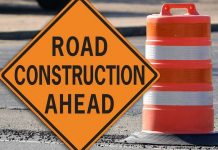
As federal and state officials across the country continue efforts to ramp up testing capacity for COVID-19, researchers and health experts have raised concerns over a continuing question: How accurate are the tests?
The answer to that question, health officials and researchers say, could have critical implications for state and local officials as they decide when millions of people can safely return to work or school and who should be quarantined as testing becomes more widespread.
Chief among the concerns are false-negative test results, or people who test negative for COVID-19 when they are, in fact, infected with the novel coronavirus.
Right now, one of the most common ways to test for COVID-19 in the United States, including Indiana, involves a process called reverse transcription polymerase chain reaction, or RT-PCR, which is designed to detect small amounts of viral RNA in nasopharyngeal, nasal or throat swabs.
[sc:text-divider text-divider-title=”Story continues below gallery” ]
Preliminary research from the Mayo Clinic and researchers in China has shown varying levels of incorrect results among RT-PCR tests, including potential rates as high as around 29%.
“There is a roughly 20 to 30% false negative rate on COVID-19 RT-PCR tests,” said Dr. Brian Niedbalski, Bartholomew County health officer. “That number is fairly consistent nationwide. We understand false negatives are a possibility. That’s why patient education about isolating appropriately is so important.”
As of Saturday, Bartholomew County had administered 1,371 total tests with 198 coming back positive, according to the local health department. The department reported 1,021 of those tests had returned as negative with 128 tests pending as of this weekend.
The county reported Saturday that 10 Bartholomew County residents have died from COVID-19.
A patient who was once believed to be Bartholomew County’s first COVID-19 fatality in late March tested negative for the virus after her death, said Bartholomew County Coroner Clayton Nolting.
On Saturday, the state began reporting a new category for deaths, listed as “probable deaths” attributed to COVID-19.
The state health department said the cause of death for 87 people in Indiana is believed to be “probable COVID-19.” Probable deaths are those for which a physician listed COVID-19 as a contributing cause based on X-rays, scans and other clinical symptoms but for which no positive test is on record. The 87 deaths reportedly happened over multiple days around the state.
It is not known precisely how many false-positive test results there have been in Bartholomew County or anywhere else. Factors that might cause a false negative include a shortage of appropriate testing supplies, using test kits that had not been extensively studied prior to their use or an error in obtaining the sample properly, Niedbalski said.
In addition, it’s possible that anyone who tested negative could have had other common bacterial and viral illness that have similar symptoms to COVID-19, including strep throat, influenza or rhinoviruses, which cause the common cold.
“Anyone with symptoms consistent with COVID-19 should assume they have it,” Niedbalski said. “They should isolate themselves until seven days have passed from the onset of their symptoms and it has been three days since their symptoms have improved, and they have gone three days without a fever.”
Researchers and health officials say expanded testing for COVID-19 is a crucial step toward resolving the COVID-19 crisis, but have raised questions about the possibility of false-negative test results, in large part, out of concern that individuals who test negative for COVID-19 may be lulled into a false sense of security and not take proper precautions to avoid spreading the virus to others.
The end result, researchers say, could be additional outbreaks of the disease fueled, in part, by patients with false-negative test results.
There have been several reports of patients who were suspected to have COVID-19, but tested negative multiple times before getting a positive result. Officials at the federal Centers for Disease Control acknowledge that false negative results are possible, suggesting that patients who test negative for COVID-19 “probably” were not infected with the new coronavirus at the time the test was taken.
One case study published in the Japanese Journal of Radiology earlier this month found that a 34-year-old man in Wuhan, China suffering from chills and a fever of 101.6 degrees tested negative for COVID-19 four times via RT-PCR tests before finally testing positive five days after being admitted to the hospital, according to the study’s authors.
However, the magnitude of false negative test results in the United States, as well as the sensitivity of some of these tests, are largely unknown, according to preliminary findings from Mayo Clinic researchers.
“It has been estimated that the COVID-19 rate in California may exceed 50% by mid-May 2020,” according to the researchers. “With a population of 40 million people, 2 million false-negative results would be expected with comprehensive testing. Even if only 1% of the population was tested, 20,000 false-negative results would be expected.”
RT-PCR testing for other viruses can be highly variable, the Mayo Clinic researchers said, adding that initial data from China “suggested relatively poor sensitivity of initial RT-PCR tests.”
Niedbalski said rapid flu tests can also have high false-negative rates, especially when flu activity is very high. For instance, during flu season, people who have flu-like symptoms should assume they have influenza, he said.
Niedbalski, however, urged Bartholomew County residents to take their symptoms seriously even if they test negative for COVID-19.
“I do feel that false negative tests give a false sense of security,” Niedbalski said. “If someone’s test is negative but their symptoms are strongly suggestive of COVID-19, then I would recommend they follow the isolation guidelines as if they have the virus.”
[sc:pullout-title pullout-title=”Where to call” ][sc:pullout-text-begin]
People with concerns or questions about potential exposure or symptoms of COVID-19 should call Columbus Regional Health’s COVID-19 Triage Resource Call Center at 812-379-4449. This phone number is staffed by trained nurses.
Visit www.crh.org/news/2020/04/06/coronavirus-update-what-you-need-to-know for more information.
[sc:pullout-text-end][sc:pullout-title pullout-title=”New state testing study” ][sc:pullout-text-begin]
A new study being done by IUPUI’s Fairbanks School of Public Health will estimate how many Hoosiers have been infected by COVID-19 and how it is affecting communities around the state.
Post cards, emails and phone calls are being made to individuals over the age of 12 selected in Indiana to be a part of the study, Menachemi said. Study officials are calibrating the effort to include a wide range of individuals with randomly selected people who represent the gender, race and ethnicity of the state’s population.
The test is free and requires individuals contacted to be participants to register for a time and date to be tested at the site the individual selects.
Participants will be notified of their eligibility for the study by mail, text message, email or phone and will be directed to the testing site closest to their residence. Registrants will receive a unique code that they will show at the testing site as proof of participation.
Initially, a baseline of 5,000 to 7,000 individuals will be established in the first testing round, which begins Saturday and concludes Wednesday. Phase 2 will begin May 23, followed by Phase 3 in October 2020 and Phase 4 in April 2021. At least 5,000 Hoosiers are being tested in each phase.
Testing will be done through the nasal swab and also a blood draw. Test samples will be taken at eight fixed drive-thru sites and 10 mobile RV sites. Phlebotomists from the Indiana National Guard will take blood samples and emergency medial service providers will do the swab specimens.
[sc:pullout-text-end][sc:pullout-title pullout-title=”About testing” ][sc:pullout-text-begin]
Because of limited supplies of testing materials, Columbus Regional Hospital officials have said relatively healthy people with a low fever and cough and are not that sick will likely be advised to stay at home and not seek medical attention.
However, people with symptoms such as shortness of breath or risk factors such as being older than 60 and/or having a compromised immune system should seek medical care and let their physician decide if a COVID-19 test will help direct their care.
Anyone with concerns are urged to call the health system’s Triage Resource Call Center, a phone resource line launched by CRH to handle calls from residents with questions and concerns about exposure or symptoms associated with COVID-19. The phone line is open daily from 7 a.m. to 8 p.m. and is staffed by registered nurses who will offer screening questions and potentially recommend a course of action for patients.
The phone resource line can be contacted at 812-379-4449.
Visit crh.org/news/2020/03/16/coronavirus-update-what-you-need-to-know for more information.
[sc:pullout-text-end]




